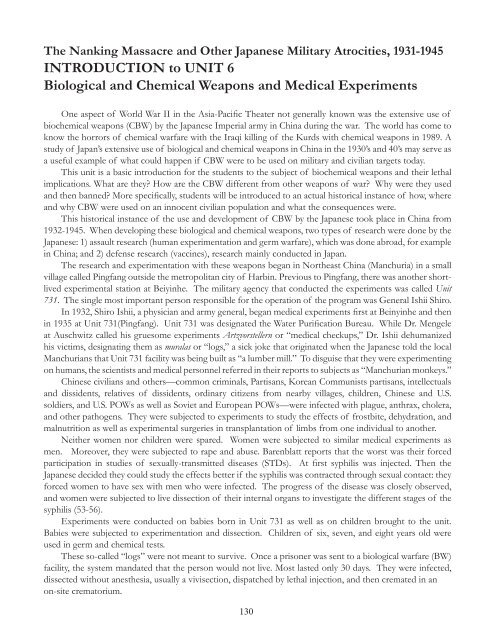Download - Canada ALPHA
Download - Canada ALPHA
Download - Canada ALPHA
You also want an ePaper? Increase the reach of your titles
YUMPU automatically turns print PDFs into web optimized ePapers that Google loves.
The Nanking Massacre and Other Japanese Military Atrocities, 1931-1945<br />
INTRODUCTION to UNIT 6<br />
Biological and Chemical Weapons and Medical Experiments<br />
One aspect of World War II in the Asia-Pacifi c Theater not generally known was the extensive use of<br />
biochemical weapons (CBW) by the Japanese Imperial army in China during the war. The world has come to<br />
know the horrors of chemical warfare with the Iraqi killing of the Kurds with chemical weapons in 1989. A<br />
study of Japan’s extensive use of biological and chemical weapons in China in the 1930’s and 40’s may serve as<br />
a useful example of what could happen if CBW were to be used on military and civilian targets today.<br />
This unit is a basic introduction for the students to the subject of biochemical weapons and their lethal<br />
implications. What are they? How are the CBW different from other weapons of war? Why were they used<br />
and then banned? More specifi cally, students will be introduced to an actual historical instance of how, where<br />
and why CBW were used on an innocent civilian population and what the consequences were.<br />
This historical instance of the use and development of CBW by the Japanese took place in China from<br />
1932-1945. When developing these biological and chemical weapons, two types of research were done by the<br />
Japanese: 1) assault research (human experimentation and germ warfare), which was done abroad, for example<br />
in China; and 2) defense research (vaccines), research mainly conducted in Japan.<br />
The research and experimentation with these weapons began in Northeast China (Manchuria) in a small<br />
village called Pingfang outside the metropolitan city of Harbin. Previous to Pingfang, there was another shortlived<br />
experimental station at Beiyinhe. The military agency that conducted the experiments was called Unit<br />
731. The single most important person responsible for the operation of the program was General Ishii Shiro.<br />
In 1932, Shiro Ishii, a physician and army general, began medical experiments fi rst at Beinyinhe and then<br />
in 1935 at Unit 731(Pingfang). Unit 731 was designated the Water Purifi cation Bureau. While Dr. Mengele<br />
at Auschwitz called his gruesome experiments Artzvorstellern or “medical checkups,” Dr. Ishii dehumanized<br />
his victims, designating them as muralas or “logs,” a sick joke that originated when the Japanese told the local<br />
Manchurians that Unit 731 facility was being built as “a lumber mill.” To disguise that they were experimenting<br />
on humans, the scientists and medical personnel referred in their reports to subjects as “Manchurian monkeys.”<br />
Chinese civilians and others—common criminals, Partisans, Korean Communists partisans, intellectuals<br />
and dissidents, relatives of dissidents, ordinary citizens from nearby villages, children, Chinese and U.S.<br />
soldiers, and U.S. POWs as well as Soviet and European POWs—were infected with plague, anthrax, cholera,<br />
and other pathogens. They were subjected to experiments to study the effects of frostbite, dehydration, and<br />
malnutrition as well as experimental surgeries in transplantation of limbs from one individual to another.<br />
Neither women nor children were spared. Women were subjected to similar medical experiments as<br />
men. Moreover, they were subjected to rape and abuse. Barenblatt reports that the worst was their forced<br />
participation in studies of sexually-transmitted diseases (STDs). At fi rst syphilis was injected. Then the<br />
Japanese decided they could study the effects better if the syphilis was contracted through sexual contact: they<br />
forced women to have sex with men who were infected. The progress of the disease was closely observed,<br />
and women were subjected to live dissection of their internal organs to investigate the different stages of the<br />
syphilis (53-56).<br />
Experiments were conducted on babies born in Unit 731 as well as on children brought to the unit.<br />
Babies were subjected to experimentation and dissection. Children of six, seven, and eight years old were<br />
used in germ and chemical tests.<br />
These so-called “logs” were not meant to survive. Once a prisoner was sent to a biological warfare (BW)<br />
facility, the system mandated that the person would not live. Most lasted only 30 days. They were infected,<br />
dissected without anesthesia, usually a vivisection, dispatched by lethal injection, and then cremated in an<br />
on-site crematorium.<br />
130


